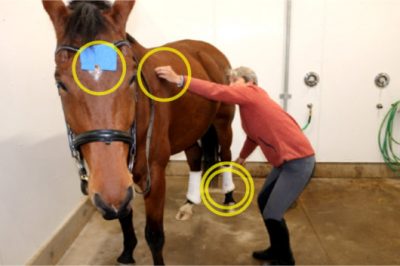I recommend you read the human injury recall section starting on page 76. I assume the horse’s nervous system, like the human’s, is capable of recording an injury event. When are injured our nervous system responds with muscle and joint contractions as a protective mechanism. It is believed the contraction or avoidance reaction stays embedded within the nervous system. The resulting neuropathway can prevent normal biomechanical movement from being free and flowing. For example, a previous trauma to a leg joint, even though completely healed, may prevent the animal from striding out confidently. Deep in the nervous system, the trauma pathway may be protecting the horse against striding out. Indeed, under the guidance of an experienced horse trainer, we were able to assess for and remove the memory pathway of previous injuries on a number of horses. It helped that the owners were fully cognizant of the location of each horse’s previous injury. This enabled us to go directly to the site of the previous injury to determine if the trauma event was stored in the horse’s nervous system.
IRT for Joint Injuries

In this procedure, only the surrogate wears a device on the midline CV. The horse does not wear a clip. This is due to the nature of the physics involved when it interacts with the horse’s central nervous system to determine the location of previous trauma. Muscle test the surrogate and find a reliable muscle. Next, have someone hold the device against the joint you think may have been traumatized and test the surrogate’s muscle. If there is an inability to lock the muscle, then an injury recall pathway exists. The correction is done by rubbing a device over the anterior aspect where the long pastern and canon bones meet (the fetlock) while rubbing another device over the trauma for 10 seconds. This procedure removes the nervous systems remembrance of the trauma reaction. In humans, there can be significant results as per the testimonials on page 81. In my experience with humans, the removal of embedded trauma pathways reduces the amount of neurological disorganization of the nervous system. This can be measured by doing eyes into distortion assessments on human’s (see Appendix 2). We assume IRT on a horse will have the same result and hopefully help it to perform and used its muscles more efficiently.

In this picture, Sarah is IRT testing around the TMJ. If the horse had been kicked here for example, and the trauma was significant, the surrogate will test “weak”. Scan the area of suspected trauma while testing the muscle.
The correction will require you to clip a device over the horses fetlock -the anterior aspect where the long pastern and canon bones meet. At the same time trace over the injury location with another clip for 10 seconds.
IRT for Muscle Injuries

It is common to have a muscle injury recall pathway in humans, so it is wise to assess for a possible muscle injury recall pathway in horses. The assessment is similar in that the surrogate wears a clip, but the horse must have a clip placed between its eyes. This is similar to testing for muscle spindle disconnections except the horse does not have a clip at the throat latch position. Use the surrogate to scan for suspected muscle injuries on the horse. If the surrogate tests weak while scanning a muscle, place the 3rd clip on the horse’s anterior rear fetlock while coursing over the traumatized muscle with a clip. The fetlock correction does not equate to the ankle in humans, but it does seem to work.
In this picture, Sarah is scanning the shoulder muscles for a muscle injury recall. Note the clip attached to the vet wrap and positioned between the horse’s eyes. Sarah, the surrogate, is wearing a clip on her midline CV. The horse does not have a clip on the CV for injury recall testing.

The correction. In this picture, Sarah is coursing over the shoulder muscle where she located a trauma pathway with one clip, while another clip is attached at the horse’s fetlock. Note the mid-eye position clip must be present in order to remove the injury pathway of the muscle.
Summary of IRT for Joints and Muscles
- Only the surrogate wears a device on the midline.
- For testing spinal joints, peripheral joints or areas of trauma, hold another device over the trauma position. If the surrogate muscle tests “weak” you may have located a hidden trauma pathway.
- To correct, hold one device over the anterior fetlock of either rear leg at the junction of the pastern and canon bone, and another over the area of trauma. If fetlock is traumatized hold a device over it and use the opposite fetlock to make the correction.
- Follow the same procedure for muscle injuries but make sure you place a device in the mid-eye position. The correction procedure is the same as long as the clip remains in the mid-eye position when you place the clip over the anterior fetlock of either rear leg.
Where to buy
Equine Neuro Connect™ Clips
Vibrant Equine Healing sell Equine Neuro Connect™ Clips locally and ship anywhere in Canada as the Canadian Independent Distributor, to order please contact us. For orders outside Canada, you can find these clips along with Dr. Mark Metus’s other products available for sale at https://neuroreset.ca/products
Quantum Alignment Technique eBook
Download a free copy of Dr. Mark Metus’s step by step guide to using Quantum Instruments to identify and help support the symptoms of neuromuscular conditions as well as spinal and peripheral joint issues in both humans and horses.
Dr. Mark Metus’s new book is also available from Amazon in the Kindle format. Simply download the free Kindle application which can be used to read the book on any computer, tablet or phone and search for ‘Quantum Alignment Technique’.
Click here to download a copy of the QAT Self Treatment Routine flyer. Please visit the NeuroReset website to find out more.

